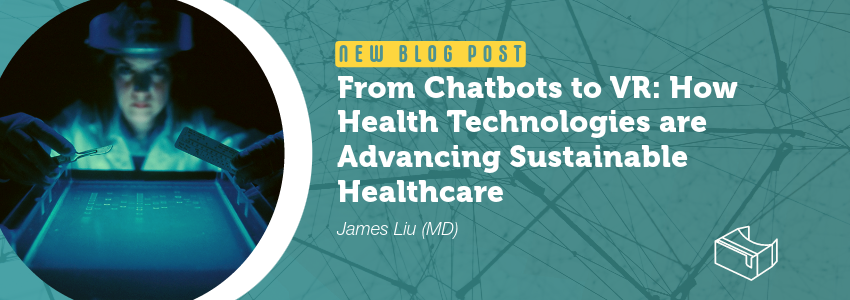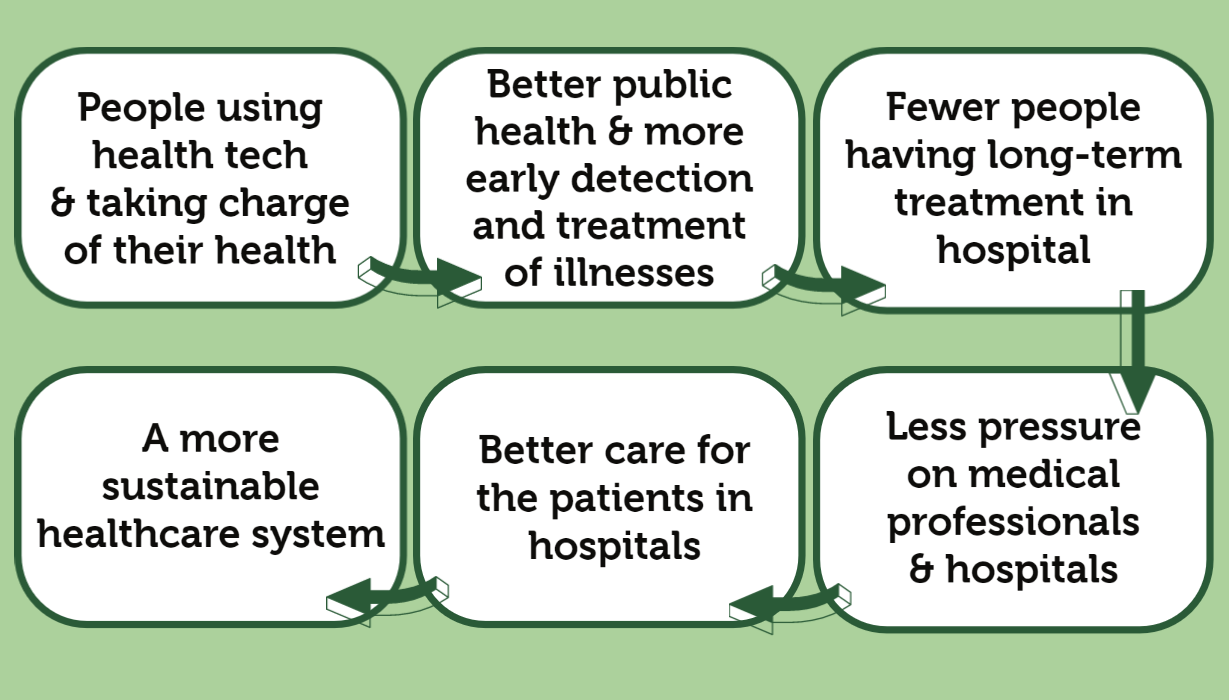Highlighting the sustainable benefits of health technology
How can innovative health technology be used in the healthcare sector? Read James’s blog post to discover how artificial intelligence and virtual reality can help reach sustainability goals in global health…
 James is the on-site GP and Health Advisor for the Salty Creek Community Festival, and he’s organising the Health Sector Industry Booth. James loves talking about cutting-edge innovation in health — he even writes a popular blog on the topic.
James is the on-site GP and Health Advisor for the Salty Creek Community Festival, and he’s organising the Health Sector Industry Booth. James loves talking about cutting-edge innovation in health — he even writes a popular blog on the topic.
James knows that one of the festival’s main goals is to raise awareness of sustainability, so he’s decided to write a blog post on how health technologies can contribute to sustainability.
Check out James’s blog post to read his thoughts on where healthcare, technology, and sustainability meet.

JamesLiuSaltyDoc | healthtech enthusiast – 2d ago
I’ve recently taken on a role helping to organise and run a community festival in my hometown, Salty Creek. The festival’s focuses are sustainability, local talent, and the future of our town. As readers of this blog will know, ‘the future’ is my favourite thing to write about, especially when it comes to new developments in health tech. The festival role has given me a chance to think about the ways health technology innovation is supporting global sustainability efforts.
Sustainability in health isn’t just about clean air, safe drinking water, and responsible disposal of waste, though all these things are vital to human health and healthy societies. Sustainability in health is also about ensuring that expertise is shared globally, research and services are resourced, patients can afford quality care, and medical professionals are given what they need to do their job well.
 The United Nations’ Sustainable Development Goal 3 (SDG 3) aims to ensure healthy lives and promote wellbeing for all ages. It seeks to end preventable deaths, fight diseases, promote mental health, reduce road deaths and those caused by pollution, prevent and treat substance abuse, and strengthen the capacity of all countries to provide affordable and safe access to quality healthcare, family planning and education, medicines, and vaccines.
The United Nations’ Sustainable Development Goal 3 (SDG 3) aims to ensure healthy lives and promote wellbeing for all ages. It seeks to end preventable deaths, fight diseases, promote mental health, reduce road deaths and those caused by pollution, prevent and treat substance abuse, and strengthen the capacity of all countries to provide affordable and safe access to quality healthcare, family planning and education, medicines, and vaccines.
The global pandemic showed us that healthcare systems in both developing and developed countries can be pushed to breaking point by unexpected circumstances. Many systems have been shown to be unsustainable, meaning that they can’t continue functioning properly under pressure. Many hospitals are understaffed because there aren’t enough qualified specialists, and existing employees spend a lot of time doing paperwork, all of which places a large burden on the system. These issues limit the quality of treatment options and attention patients receive.
Health tech can make healthcare more sustainable by supporting these systems and removing the burden on medical practitioners and hospitals. There are so many fascinating ways health technologies are contributing to SDG 3 and plenty of opportunities for greater improvement and innovation. Like with many new technologies, there are ethical issues to consider when it comes to health tech, and we must remember that things like AI aren’t a fix-all. That said, this post is about the ideal ways tech innovations can help make healthcare sustainable.
 AI-based tools are computer programs that use artificial intelligence to analyse images, videos, sound recordings, and other health data to detect and predict medical issues. The part that excites me the most about AI in healthcare is the great strides that are being made and will be made in health research.
AI-based tools are computer programs that use artificial intelligence to analyse images, videos, sound recordings, and other health data to detect and predict medical issues. The part that excites me the most about AI in healthcare is the great strides that are being made and will be made in health research.
AI can scan data at a much faster rate than we can. It can be used to review large amounts of data, speeding up the process of medical discovery. It can also be used to generate detailed models of diseases and drug interactions to help develop more precise treatments. Research programs in these areas can help us fight communicable and non-communicable diseases and increase the global quality of healthcare services.
AI can help ease the burden on medical professionals and bridge the skills gap in places where there are shortages of training opportunities and specialised medical practitioners. It can also be used to help diagnose patients quickly and accurately, as well as offer guidance and quality control.
For example:
- Powerful machines and AI programs can analyse scans 150 times faster than radiologists and can work 24 hours a day.
- AI can be an excellent support tool in the diagnosis of melanoma, especially in areas without specialists, and smartphone applications will soon be able to accurately diagnose a photo of a skin lesion.
- AI can be utilised to help screen patients for eye conditions in areas with a critical shortage of health practitioners and facilities. Check out the case study below to learn more. You might be interested to know that I actually used an AI program to help me draft and format it!

Virtual Reality devices can be used to create immersive learning environments and simulate medical procedures, allowing doctors to practise before performing the actual procedure. VR programs can also be created to train medical professionals in areas where there may be a skill shortage. Of course, this technology has limitations, as it requires good internet infrastructure, meaning developing areas may not be able to use it.
VR is also a promising tool for treating addiction. It can be used to simulate real-life situations that may trigger cravings or other addictive behaviours. This allows the user to practise coping strategies in a safe environment. What’s more, putting on a headset and being immersed in different environments can act as therapeutic support for hospitalised patients, and those suffering from mental health issues such as anxiety, depression, and phobias, as well as drug and alcohol addiction.
 A chatbot is a computer program that uses AI to simulate conversations with humans through text, audio, or video. You might have seen basic versions pop up in the corner of websites asking if they can help you. They’re getting more sophisticated and knowledgeable by the day.
A chatbot is a computer program that uses AI to simulate conversations with humans through text, audio, or video. You might have seen basic versions pop up in the corner of websites asking if they can help you. They’re getting more sophisticated and knowledgeable by the day.
Chatbots can help support patients while also making medical professionals’ workloads more sustainable. They are now being used to respond to patients’ queries and give basic health advice, reducing the workload of medical staff in hospitals. There are also chatbots that can help users with depression and anxiety by giving them a safe space to talk through topics. This is extremely useful where there might be a lack of affordable mental health care and/or in-person therapists. Chatbots can also resolve language barriers, and provide 24/7 support.
 Wearable devices are tech gadgets designed to be worn on the body. They capture and monitor data, such as fitness and health information. Some well-known examples include smartwatches and fitness trackers. They can help track patients’ health conditions and collect health data that can be used with a personalised treatment plan. These devices can also give users reminders to take medication or make a medical appointment, and users can choose to have information sent to their care providers. Devices like these can empower people to take charge of their own health before illnesses develop, tackling non-communicable diseases and easing the strain on healthcare providers.
Wearable devices are tech gadgets designed to be worn on the body. They capture and monitor data, such as fitness and health information. Some well-known examples include smartwatches and fitness trackers. They can help track patients’ health conditions and collect health data that can be used with a personalised treatment plan. These devices can also give users reminders to take medication or make a medical appointment, and users can choose to have information sent to their care providers. Devices like these can empower people to take charge of their own health before illnesses develop, tackling non-communicable diseases and easing the strain on healthcare providers.

DID YOU KNOW?
People aged 80 years and over are part of the fastest-growing age group. The number of people in this demographic is projected to triple between 2018 and 2050, reaching 426 million.
Sustainable healthcare systems will only become more important with the aging of the global population. Reducing the number of elderly patients who require expensive long-term hospital treatment is crucial. Wearable devices, VR, and AI make patients more aware of their health and how to maintain their wellbeing. These improvements mean in the future, more patients can find answers to their questions and receive support without going to the hospital. They can also be treated at home, which will reduce medical wait times, prevent the spread of hospital-acquired diseases, and therefore reduce the burden on hospitals.
Statistic source:
Population Division of the United Nations (UN) Department of Economic and Social Affairs (2019) World Population Prospects 2019: Highlights, UN website, accessed 15 February 2023. https://population.un.org/wpp/Publications/Files/WPP2019_10KeyFindings.pdf
Health tech is an evolving field and a thrilling frontier – and I’ve only included a few examples in this post (next time I’ll delve into AR, robotics, and 3D printing as well). I hope you find these innovations as exciting as I do and can see the many ways they can contribute to global healthcare and sustainability. They offer more sophisticated remote care and training and give medical professionals more time to focus on quality health care. They make it easier to sift through information, find answers faster, and give accurate diagnoses.
I think it’s vital for healthcare specialists to keep up to date with new developments in the sector, and we should also be building our knowledge of sustainability. The need to protect our planet and patients through sustainable innovation won’t be going away, and an understanding of the SDGs can give us a more complete view of the many ways sustainability, health, and technology are interconnected.
Sources:
United Nations (2015) Goal 3: Good Health and Well-being [graphic], United Nations SDGs website, accessed 30 January 2023. https://www.un.org/sustainabledevelopment/news/communications-material/
The Economist (2019) ‘Is this the future of health?’ (video), The Economist, YouTube, accessed 15 February 2023. https://www.youtube.com/watch?v=jZg5QhL3Ckc
Sweeney, C., Potts, C., Ennis, E., et al. (2021). ‘Can Chatbots Help Support a Person’s Mental Health? Perceptions and Views from Mental Healthcare Professionals and Experts’, ACM Transactions on Computational Healthcare, 2(3):1-15, doi:10.1145/3453175.
Mar, V.J. and Soyer, H.P. (2018) ‘Artificial intelligence for melanoma diagnosis: how can we deliver on the promise?’, Annals of Oncology, Elsevier, doi:10.1093/annonc/mdy193.
Reflect
How can the technologies James has written about in his blog post help support the SDG 3 targets (which are listed in the drop-down menu above)?

What are some barriers that might stand in the way of using these technologies to reach SDG 3?
For example, Target 3.8 is to help people access medical care no matter where they are in the world.
- How could a chatbot or wearable device help people receive the health care they need, even if they live in remote and/or developing areas?
- What if the area doesn’t have a reliable internet connection, or the local population cannot afford wearable devices like smartwatches?
James mentions that AR, robotics, and 3D printing are also health tech developments. What do you know about these technologies? In what ways could they be used in healthcare?
Health tech is only one of the many professional areas where innovations are being used to help address global inequalities in health and quality of life. Sustainability literacy is a skill that is growing in importance in all areas, especially in STEM, and is highly valued in higher education and by forward-thinking employers. Being aware of the Sustainable Development Goals, and the needs and opportunities which exists in these multiple, interconnected areas will help you make informed and positive choices for yourself and your community.

- Want to see how Sammie and Hayden explain sustainability to the volunteers and share their ideas for running a sustainable festival? Check out the Making a festival sustainable page. (10 to 15 minutes)
- Now that you’ve learnt all about how technology can make healthcare more future-focused and sustainable, you might want to check out the exciting developments in other areas. Head over to the Engineering Industry Booth where Mia’s friend Ewan is exploring innovation and sustainability in agricultural technology. (15 to 30 minutes)
Learn more on Learning Lab
- Now you know more about Sustainable Development Goal 3, why not learn more about the other UN SDGs? (20 minutes)
- Read about the ways RMIT University is working towards Goal 14 – Life Below Water. (10 minutes)
The United Nations Sustainable Development Goals are a collection of goals with targets and methods, shared by a global partnership of developed and developing nations. They focus on a range of interconnected issues and aim to improve sustainability and quality of life globally.
A person who possesses the knowledge, skills, and mindset of sustainability literacy recognises the importance of building a sustainable future. They can make informed and effective decisions to this end by considering a balance between social wellbeing, economic stability, and care for the environment.
STEM is a commonly used term in education and is used to refer to a collection of interrelated technical disciplines. It stands for Science, Technology, Engineering, and Mathematics.

